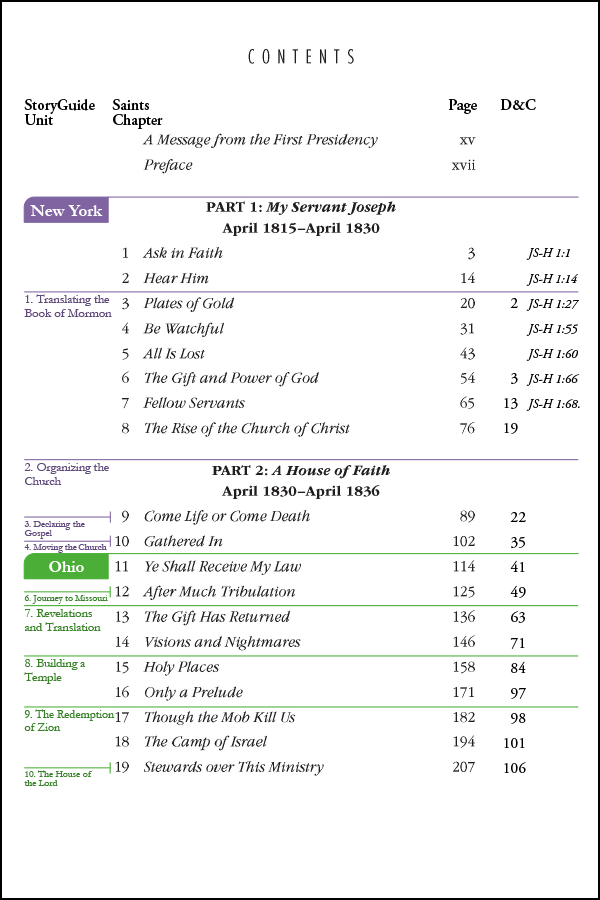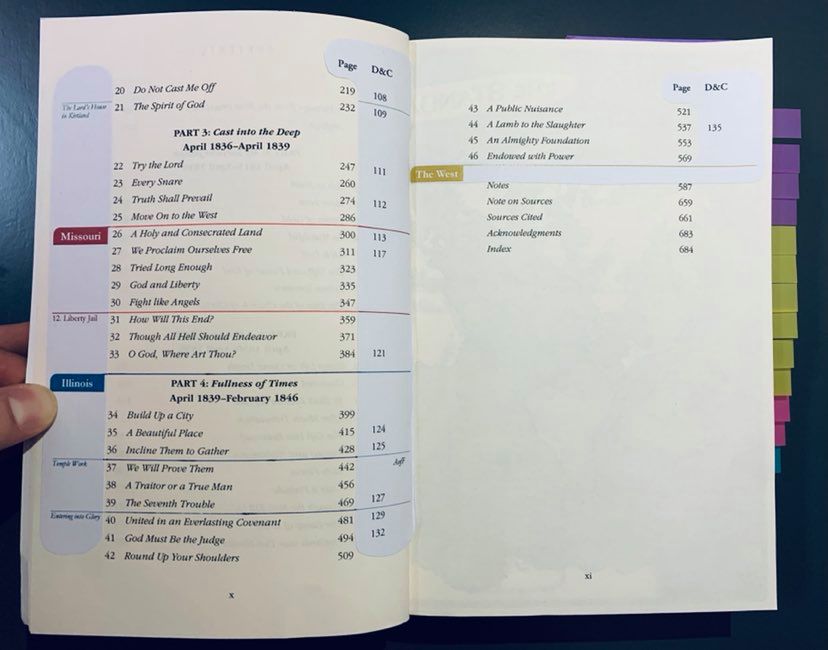This is the table of contents of Saints (volume 1), The Standard of Truth, with section numbers added (right-hand margin), so readers can see which Saints chapters cover the same time period as a particular string of D&C sections. For example, in the time period recounted in Saints chapter 7, D&C sections 13–18 were also received. This should make it easier for people trying to read Saints in tandem with the Doctrine and Covenants.
This printable table of contents also has labels and lines added (left-hand margin) to show how the Saints chapters line up with the major divisions (i.e., “parts” and “units”) in the StoryGuide Doctrine and Covenants. Thus reading Saints in tandem with the D&C is even easier if you use the StoryGuide edition, which is part of a series of volumes of redesigned scriptures.

I would suggest cutting out the strips on the right and left sides of the page and pasting them into the margins of your hard copy of Saints. That should make it easier to see where you are in the larger Saints story as you thumb through your scriptures. It should also help you pace your reading of Saints as you work your way through the Come Follow Me reading schedule for the Doctrine and Covenants this year.

Note that the colors of the five major parts (New York, Ohio, Missouri, Illinois, and the West) correspond to the color scheme used in the Geographical Timeline of early Church History.
Why divisions in different locations?
A quick glance will show that Saints divides the story of early Church history into parts in slightly different places compared to where the StoryGuide Doctrine and Covenants does. Why might that be?
Well, ultimately the decision of how to divide up any story is very subjective and depends on how you want to tell it. The divisions could be made a dozen different ways depending on what you want to emphasize, how you trace cause and effect, which characters you try to follow most closely, etc. The division of any sizable story is going to depend on the priorities and approach of the author. This doesn’t necessarily mean that one approach is right while all others are wrong. For example:
- The Church’s publication Our Heritage: A Brief History of The Church of Jesus Christ of Latter-day Saints divides the time periods by geographical region, similar to the StoryGuide. (Interesting, Our Heritage is so wed to geography that it makes a major years-long flashback in the chapter on Missouri).
- The Church’s publication Church History in the Fulness of Times has dozens of chapters but no higher-level part divisions. And in some places it uses “flashbacks,” such as in the three chapters on the Nauvoo period: it covers the same span of years three different times, covering three different topics (daily life, doctrinal developments, and growing conflict).
- The Church’s publication Saints volume 1, The Standard of Truth, appears to divide the time periods by “spiritual climax,” for lack of a better label. That is, instead of ending part 1 with the move to Ohio, it ends it earlier with the organization of the Church. And instead of ending part 2 with the move to Missouri, it ends it earlier with the appearance of the Savior in the Kirtland Temple.
Any of these approaches can be a fruitful way of telling the story, drawing out different threads in the story. I really like the choice made by the authors of Saints to focus on spiritual climaxes; it draws attention to the enduring impact made by those events which are still felt in the lives of Church members. In contrast, “Ohio” is not a doctrine that affects the Saints’ daily lives today.
So why did I choose to divide the time periods by geography? Well, partly because it’s more objective. The location of a revelation’s reception is a fairly straightforward matter; its relative significance was a harder call for me to make. Where possible in the StoryGuide, I try not to heavily interpret when there are not compelling reasons to. That said, I think the authors of Saints did an excellent job in gauging the enduring significance of the climaxes they highlighted. They are generally more knowledgeable than I on the subject, and have much greater access to Church leaders’ priorities as expressed in Church councils.
For those interested, I hope this has been a helpful examination of the division of Saints into parts and chapters (and of the StoryGuide D&C into parts and units). Whichever approach one prefers, I think the important thing is that readers get familiar with the basic outline of Church history. If they come to know the storyline well enough to argue a different approach than the one I used, I’ll consider my efforts a rousing success!